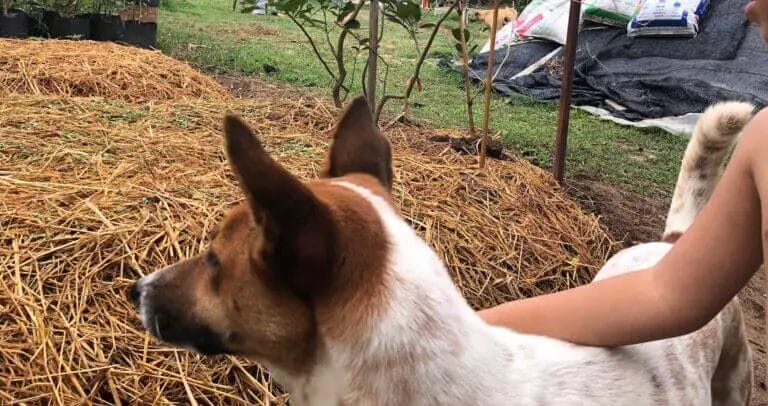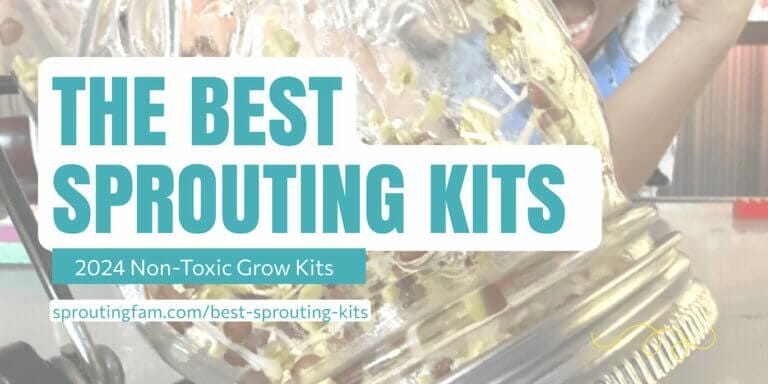Sproutingfam.com is supported by its readers. If you purchase through a link on my site, I may earn a commission. Learn more
DIY Aquaponics: Getting Started With Aquaponic Farming
Aquaponics has been called a disaster-proof method of growing food. If you’re looking for a weather-proof way to grow organic food at home, Aquaponics (hydroponics minus the chemicals) is a newer trend going on in the world of farming for its major upsides once you get going.
And it’s a good way to go.
What is Aquaponics?
Home DIY aquaponics systems are hydroponics without the chemicals, plus fish.
With aquaponics, you grow fish and plants together. What you end up with are very healthy fish and huge, nutrient-packed fruit and vegetables.
Aquaponic gardening requires no soil.
For lighting, natural sunlight or grow lights can both be used. Sunlight is always best. It’s good to see sun-grown aquaponics systems growing in popularity. It’s one of the promising trends right now in the home food growing world.
This post introduces DIY aquaponics systems in a very broad way. Being stewards of the Earth, it’s important to look into eco-friendly gardening solutions that can lessen impacts of mass agriculture and people’s reliance on it.
Farming requires a lot of equipment and labor. And the great thing about Aquaponics is that it cuts out most of it. While I love my truck and bike, and while I don’t plan on ever sitting in an electric car or bike, eliminating the need for diesel consumption throughout the farming process could only be beneficial.
4 Benefits Of Aquaponics Home Gardening
- Conserves water: Because you cover the water, it doesn’t evaporate much. The end result is that 90% of the water introduced into the system is captured! You only use 10% of the water! This is a very desert-friendly farming method.
- Food is extremely nutrient rich: Thanks to the fish, the water is always clean, the plants are always getting the right nutrients, and best of all, there are absolutely NO pesticides in aquaponics.
- There are no limits: You can do it at home for you and your family, or you can grow it into a full-scale business that supports your local community.
- Lets you grow food anywhere: From deserts to snow, you can do this successfully anywhere, all year long.
Aquaponics Can Promote Bartering
Fresh picked is always better. Aquaponics offers a unique way to always have fresh picked fruits and vegetables. For example, if you pick a lime off its tree, the lime is covered in a fragrant lime oil that has a strong, wonderful scent. You wouldn’t ever know this if you’ve only ever bought limes at the market. These you have to scratch or cut open to get that strong lime scent out.
As for a self-sustainable system, fish would be the key. Tilapia, cray fish, and any fast growing fish species can be a part of the aquaponics system. Even lobsters and crabs are successfully farmed with aquaponic systems.
DIY Geodesic Dome Aquaponics Greenhouse

If you live in harsh weather conditions, you can use grow lights and do aquaponics indoors. However, sunshine is best. To still be able to use sun for your home aquaponics system, there are people who have had success with geodesic domes.
Inspired by the work of Buckminster Fuller, the geodesic dome greenhouse provides an excellent solution to harsh weather conditions. There are many books out on the geodesic domes that shares plans on how to build your own. And there are also actual easy to set-up geodesic domes for sale on Amazon and elsewhere online.
These 3 books offer well rounded information, starting from Buckminster Fuller’s geodesic dome patent, to Hugh Kenner’s practical manual for its construction to newer greenhouse specific use cases for geodesic domes. All are good books if you’re embarking the journey of building your own geodesic dome greenhouse and garden:

Buy Ready-Made Geodesic Domes
Here below are a few geodesic domes you can buy outright.
This first geodesic dome kit below is the most affordable of the dome kits. It does not have the wood sticks you would need, but it has the hubs and ball connectors that all geodesic domes rely on. As well as the hardware needed to screw it all together.
You could use this one with a bit of ingenuity to come up with a very affordable and high quality geodesic dome greenhouse:
- Simple to snap together connectors that make durable geodesic domes quick, fun and easy to build.
- The kit contains everything you need except for the sticks.
- Scaleable – choose the size that suits you
- Stainless steel metalwork
- Automotive Grade, UV resistant plastic
And here are 2 more geodesic dome greenhouse ready made options that have plenty of customer reviews and questions that give a lot of information that’s good to read before buying.
- Tierra Garden 50-2510 Haxnicks Garden Sunbubble Greenhouse, Large
- INSTANT GREENHOUSE – Our Haxnicks Garden Sunbubble Greenhouse is an exciting, dome-shaped, instant plant house/conservatory The Haxnicks Sunbubble Greenhouse is easy to set up, easy to move and easy to store Our unique, patented one-piece folding design means you can have a beautiful, quality greenhouse in your garden in just minutes
- ADJUSTABLE – The Sunbubble is built to work for you Featuring adjustable vents that let you adjust the temperature to optimal growing conditions and a strong, zipped doorway to keep nosy pets at bay, you can personalize your Sunbubble Greenhouse to meet your needs When you're taking a break, pack the greenhouse away in the sturdy storage bag for safekeeping
- INNOVATIVE DESIGN – The innovative dome shape provides ample room for plants and greenhouse staging Made from UV stabilized PVC and flexible fiberglass rods, Sunbubble is both sturdy and adaptable to your gardening and outdoor needs
- MAXIMUM SUNLIGHT – Sunbubble Greenhouse makes it easier than ever to keep your plants happily outdoors in the sun! The curved shape of the Sunbubble makes it warm up quicker than a traditional greenhouse Because of the curve, the surface stays at 90 Degrees to the direction of the sun all day long, achieving minimum reflection and maximum penetration of light,
How To Get Started With Aquaponics
There are good books on the subject. And as far as leaders in the space, Aquaponics Expert Murray Hallam and his murrayhallam.com website is one of the best places to start.
Murray Hallam teaches others how to discover the potential of aquaponics and is one the very best for learning DIY aquaponics. If you’re looking to take action on it right away, his website has all the learning materials you will need.
The Aquaponics System Model Relies on Fish
The end result is a suspension system that has biologicals floating around in the water.
Microbes break down fish waste into food that plant roots love and take right up.
However, you’re not smothering your root systems with fish poop. How it works is tiny microbes first break down fish poop into nitrites and nitrates that roots then soak up. This is what makes aquaponics so effective. Without fish, it would not be as good.
Aquaponics VS Hydroponics
Hydroponics requires you to use chemicals for the plants. This means it’s not a closed system. Part of what makes aquaponics so great, other than the fact that you don’t use chemicals, is that it can truly be a closed system.
Closed system farming means you don’t rely on anything external, such as chemicals or even fish pellets. Duck weed can potentially replace fish pellets. Replacing fish pellets with some locally sourced food would make it a true closed system.
Hydroponics is not a closed system.
Aquaponics is a true closed system.
For fish, you would have a separate breeding tank for the small fish. These then get introduced to the aquaponics system, co-habitating with the larger fish.
What About Power For Lights (And pump for towers)?
In order to cap off this high efficiency closed system, you need a source of power for an indoor lighting system if that’s what you’re going with. A few options for power:
- Solar Panels
- Wind generation
- Deep cycle marine batteries
And then as an emergency backup, you can have your gas powered generators.
2 DIY Aquaponics Systems
You can use growing towers or water based tanks. The options are endless once you see how it works. Some aquaponic farmers have truly creative setups created thanks to towers.
1. Growing Towers
The essential thing needed is a small sprinkler that creates droplets of water that constantly go down into the tube and drip into a material for growth such as a natural sponge like substance. This surface eventually has microbes that grow onto it and the roots from plants also grow into this growth medium used in the vertical tube.
An energy efficient pump makes this possible.
Every plant must have its roots grow into the growth material you stuff the vertical tube with.
Because the growth medium sponge-like material you use to stuff the tube with has microbes that grow throughout it, the fish waste pumped up from the water below will be broken down into the nutrients that the plants take up.
2. Aquaponics Boxes

The box can be made with an unused food grade plastic shipping container. These shipping containers come with an outside metal frame already formed around it.
An electric jigsaw can then easily cut it into the shape needed for the open top aquaponics box.
Aquaponics Compliments High Efficient Farming
You can build an aquaponics system from all recyclable materials. High volume, low pressure water pumps that can run off just 12V are all the power generation you’d need. An efficient 12V battery would be sufficient. This could then be backed up by an inverter running off a solar cell or wind generator.
Note: Bee raising is an essential skill to learn for aquaponics systems because of plants that require pollination.
Anyone Can Start To DIY Aquaponics
In this day of everyone relying on the grocery store, it’s important to think back to our grandparents and great grandparents and how they lived. You never know when a disaster can strike in any of various forms that force you to have to provide for yourself.
Thanks for coming by the Sprouting Fam blog.
NEXT: Learn about Korean Natural Farming (KNF), a traditional type of natural farming.
Last update on 2025-12-06 / Affiliate links / Images from Amazon Product Advertising API












